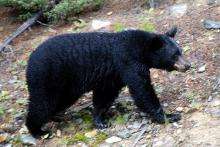June 18, 2012 report
Study shows black bears able to "count"

(Phys.org) -- Most people who have worked with black bears tend to believe the animals are pretty smart compared to say dogs or cats; others who have seen them in action, e.g. riding a unicycle in a circus, tend to agree. But, oddly enough, very little actual research has been done to find out just where black bears sit on the animal kingdom’s brainiac scale. Now a pair of researchers in the US has decided to change that by testing some captive black bears to see how they measure up against other animals in discerning the difference in the numbers of things. They have written a paper describing their findings and have had it published in the journal Animal Behavior.
The experiment they devised was very simple. Two black bears were trained to look at two groups of dots and to indicate which group they thought had fewer dots. Another bear was trained to do the opposite, i.e. indicate which he thought had more dots. As it turned out, all three bears were remarkably good at “counting” the number of dots in each group, comparing them, and then responding in a way that indicated they understood which group of dots had more and which less.
So good were the bears at picking out which group was which, the team described them as equivalent in ability to non-human primates; not bad for an animal that is pretty much a loner. Prior to testing the bears, most researchers had concluded that the ability to count was something that developed among animals that formed social groups of one kind or another. Other than when they are young and still being raised by their mothers, bears tend to hang out alone. Thus, a rethinking of how or why animals brains develop the ability to count or at least recognize which group of something has more or less, will have to be done.
To make sure the bears were really on target, the team changed the size of the dots, and the amount of space in which they were surrounded, ensuring that they weren’t just guessing based on the overall physical size of the group. After several such changes, the researchers became convinced that the only way to pick the right group as often as the bears did, was to count the dots. For the bear faced with choosing which group had more dots, the dots were even sent into motion, which for some reason, appeared to make the bear even more accurate.
It’s not likely that the bears are actually counting the dots, and in fact, the research team itself doesn’t seem convinced, using quotes to indicate that describing what the bears are able to do as counting might be a big of a stretch. Most researchers would be more likely to describe it as an advanced comparison ability.
More information: Bears ‘count’ too: quantity estimation and comparison in black bears, Ursus americanus, Animal Behaviour, dx.doi.org/10.1016/j.anbehav.2012.05.001
Abstract
Studies of bear cognition are notably missing from the comparative record despite bears' large relative brain size and interesting status as generalist carnivores facing complex foraging challenges, but lacking complex social structures. We investigated the numerical abilities of three American black bears, Ursus Americanus, by presenting discrimination tasks on a touch-screen computer. One bear chose the larger of two arrays of dot stimuli, while two bears chose the smaller array of dots. On some trials, the relative number of dots was congruent with the relative total area of the two arrays. On other trials, number of dots was incongruent with area. All of the bears were above chance on trials of both types with static dots. Despite encountering greater difficulty with dots that moved within the arrays, one bear was able to discriminate numerically larger arrays of moving dots, and a subset of moving dots from within the larger array, even when area and number were incongruent. Thus, although the bears used area as a cue to guide their responses, they were also able to use number as a cue. The pattern of performance was similar to that found previously with monkeys, and suggests that bears may also show other forms of sophisticated quantitative abilities.
Journal information: Animal Behavior , Animal Behaviour
© 2012 Phys.Org















